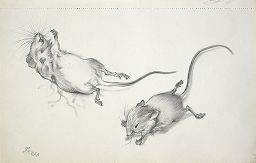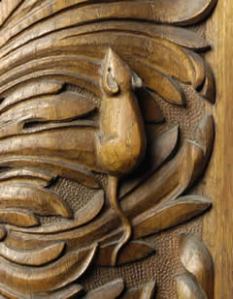 “Three blind mice/ see how they run/ they all ran after the farmer’s wife/ who cut off their tails with a carving knife…” A horrifying image dressed in a child’s verse. The English it seems gave the German Brothers Grimm a run for their money. This familiar nursery rhyme was allegedly scribbled in honor of Her Royal Highness, Queen Mary I, who also happens to be called Bloody Mary because she had an unquenchable thirst for the blood of Protestants; she, the “farmer’s wife,” who so generously had three noblemen—the eponymous mice—burned at the stake rather than their eyes poked out.
“Three blind mice/ see how they run/ they all ran after the farmer’s wife/ who cut off their tails with a carving knife…” A horrifying image dressed in a child’s verse. The English it seems gave the German Brothers Grimm a run for their money. This familiar nursery rhyme was allegedly scribbled in honor of Her Royal Highness, Queen Mary I, who also happens to be called Bloody Mary because she had an unquenchable thirst for the blood of Protestants; she, the “farmer’s wife,” who so generously had three noblemen—the eponymous mice—burned at the stake rather than their eyes poked out.
Taken out of context of 16th century England in which they originated, the unseeing mice today are but a trio of unfortunate tiny rodents, without sight and without tails. And the ambiguity of the lyrics leaves us speculating about the sequence of events—whether the mice were running after or running away from their mutilator when she slashed their tails. The celebrated poet Billy Collins, however, turns our attention to an even more pertinent question: why were the mice blind in the first place? The former Poet Laureate guesses at the answers as empathy sneaks up on him, sneaks into the lines of his “I Chop Some Parsley While Listening to Art Blakey’s Version of ‘Three Blind Mice’”:
…If it was congenital, they could be brothers and sister, and I think of the poor mother brooding over her sightless young triplets. Or was it a common accident, all three caught in a searing explosion, a firework perhaps? …the thought of them without eyes and now without tails to trail through the moist grass or slip around the corner of a baseboard has the cynic who always lounges within me up off his couch and at the window trying to hide the rising softness that he feels. By now I am on to dicing an onion which might account for the wet stinging in my own eyes, though Freddie Hubbard’s mournful trumpet on “Blue Moon,” which happens to be the next cut, cannot be said to be making matters any better.[1]But long before the three blind mice softened a cynic’s heart, America’s greatest nineteenth century painter got caught up in the nursery rhyme as well. In his early years as an artist, Winslow Homer earned his keep as a commercial illustrator. In 1858, a Boston publisher hired Homer to contribute seventeen illustrations to a children’s book. Titled Eventful History of Three Little Mice and How They Became Blind, it could almost be read as a direct response to the question Collin’s would one day pose. And like Collins, Homer and the tale’s anonymous author treat the mice sympathetically, showing us that their lamentable fate wasn’t because they were naughty but because they were mice simply being mice—in the pantry of the farmer’s wife looking for food.
.
______________________
[1] Billy Collins, “I Chop Some Parsley While Listening to Art Blakey’s Version of ‘Three Blind Mice,’” (excerpted), Picnic, Lightning, 1998.
Additional sources: Maurice Sendak, “Introduction” in Eventful History of Three Little Mice and How They Became Blind, 1996 edition, Oxford University Press; Garth Stein, “Billy Collins’s ‘I Chop Some Parsley….’,” Shambhala Sun, July 2010, p. 96.
(Image: Winslow Homer, from Eventful History of Three Little Mice and How They Became Blind, 1858, hand colored engraving, publisher: E. O. Libby & Co., Boston, Massachusetts.)









